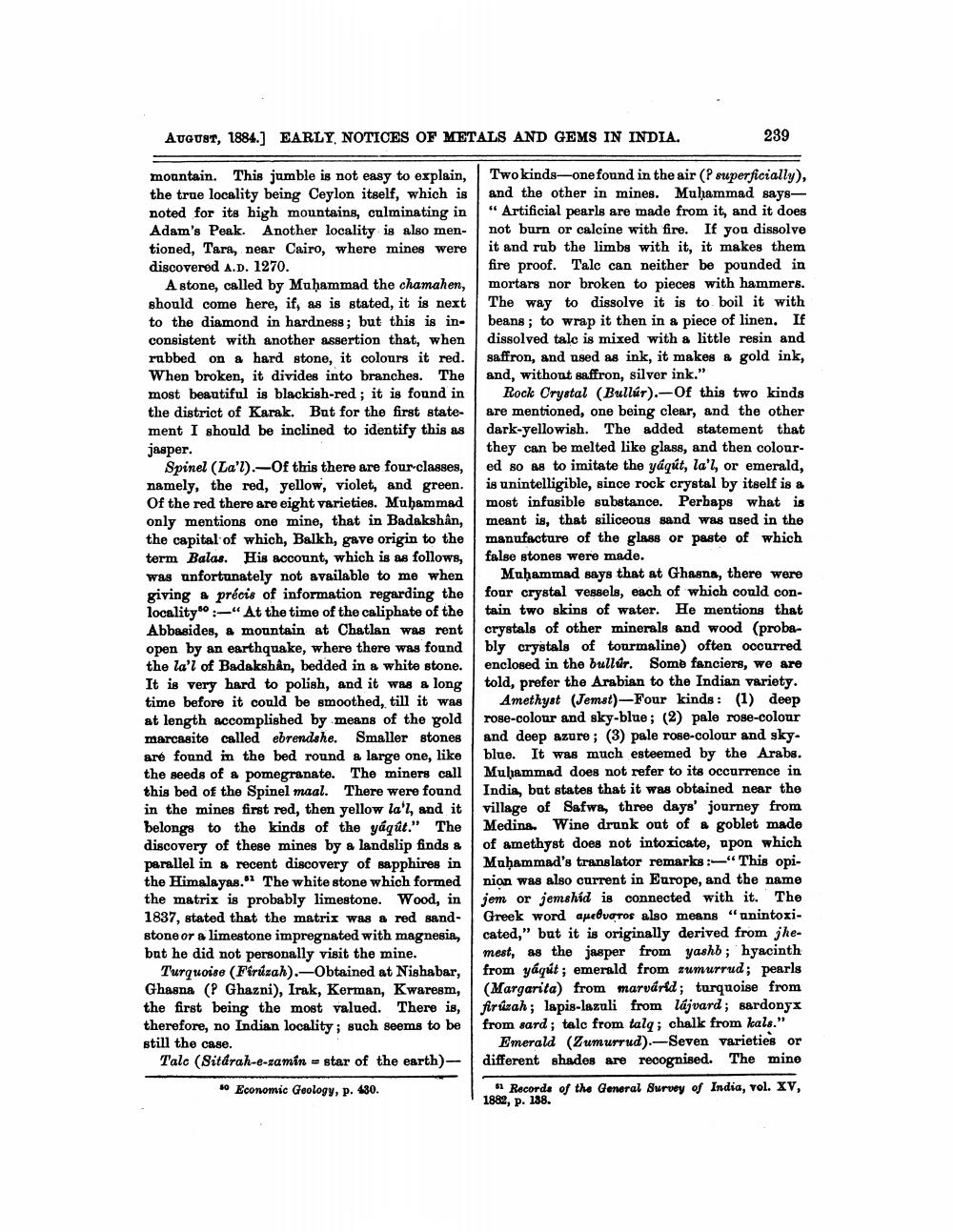________________
AUGUST, 1884.] EARLY NOTICES OF METALS AND GEMS IN INDIA.
239
mountain. This jumble is not easy to explain, the true locality being Ceylon itself, which is noted for its high mountains, culminating in Adam's Peak. Another locality is also mentioned, Tara, near Cairo, where mines were discovered A.D. 1270.
A stone, called by Muhammad the chamahen, should come here, if, as is stated, it is next to the diamond in hardness; but this is in- consistent with another assertion that, when rubbed on a hard stone, it colours it red. When broken, it divides into branches. The most beautiful is blackish-red; it is found in the district of Karak. But for the first state ment I should be inclined to identify this as jasper.
Spinel (La'l).-Of this there are four classes, namely, the red, yellow, violet, and green. Of the red there are eight varieties. Muhammad only mentions one mine, that in Badakshân, the capital of which, Balkh, gave origin to the term Balas. His account, which is as follows, was unfortunately not available to me when giving # précis of information regarding the locality :-"At the time of the caliphate of the Abbasides, a mountain at Chatlan was rent open by an earthquake, where there was found the la'l of Badakshån, bedded in a white stone. It is very hard to polish, and it was a long time before it could be smoothed, till it was at length accomplished by means of the gold marcasite called ebrendshe. Smaller stones are found in the bed round a large one, like the seeds of a pomegranate. The miners call this bed of the Spinel maal. There were found in the mines first red, then yellow la'l, and it belongs to the kinds of the yáqût." The discovery of these mines by a landslip finds & parallel in a recent discovery of sapphires in the Himalayas." The white stone which formed the matrix is probably limestone. Wood, in 1837, stated that the matrix was a red sandstone or a limestone impregnated with magnesia, but he did not personally visit the mine.
Turquoise (Firuzah).-Obtained at Nishabar, Ghasna (P Ghazni), Irak, Kerman, Kwaresm, the first being the most valued. There is, therefore, no Indian locality; such seems to be still the case. Talc (Sitdrah-e-samin - star of the earth) -
0 Economic Geology, p. 480.
Two kinds-one found in the air (P superficially), and the other in mines. Muhammad says“Artificial pearls are made from it, and it does not burn or calcine with fire. If you dissolve it and rub the limbs with it, it makes them fire proof. Talc can neither be pounded in mortars nor broken to pieces with hammers. The way to dissolve it is to boil it with beans; to wrap it then in a piece of linen, If dissolved talc is mixed with a little resin and saffron, and used as ink, it makes a gold ink, and, without saffron, silver ink."
Rock Crystal (Bullúr).-Of this two kinds are mentioned, one being clear, and the other dark-yellowish. The added statement that they can be melted like glass, and then coloured so as to imitate the yáqút, la'l, or emerald, is unintelligible, since rock crystal by itself is a most infusible substance. Perbaps what is meant is, that siliceous sand was used in the manufacture of the glass or paste of which false stones were made.
Muhammad says that at Ghasna, there were four crystal vessels, each of which could contain two skins of water. He mentions that crystals of other minerals and wood (probably crystals of tourmaline) often occurred enclosed in the bullar. Some fanciers, we are told, prefer the Arabian to the Indian variety.
Amethyst (Jemst)-Four kinds : (1) deep rose-colour and sky-blue; (2) pale rose-colour and deep azure; (3) pale rose-colour and sky. blue. It was much esteemed by the Arabs. Muhammad does not refer to its occurrence in India, but states that it was obtained near the village of Safwa, three days' journey from Medins Wine drunk out of a goblet made of amethyst does not intoxicate, upon which Muhammad's translator remarks :-“This opinion was also current in Europe, and the name jem or jemshid is connected with it. The Greek word apeOvatos also means "unintoxicated," but it is originally derived from jhemest, as the jasper from yashb; hyacinth from yáquit; emerald from sumurrud; pearls (Margarita) from marvárld; turquoise from firúzah; lapis-lazuli from lájvard; sardonyx from sard; tale from talq; chalk from kals."
Emerald (Zumurrud).-Seven varieties or different shades are recognised. The mine
51 Records of the General Survey of India, vol. XV, 1882, p. 188.




